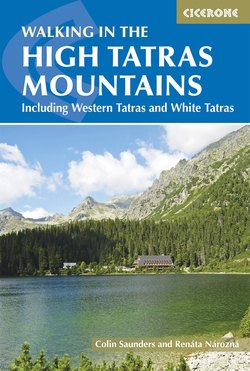Читать книгу The High Tatras - Renáta Nározná - Страница 7
На сайте Литреса книга снята с продажи.
ОглавлениеPREFACE
In August 1988 I had the very good fortune to be sent, all expenses paid, by my then employers, a tour operator specialising in walking holidays, to undertake a feasibility study into the High Tatras as a new walking centre. I was most impressed, not only by the beauty of the area, but by the enthusiasm of the local people for their mountains, none more so than that of my guide, Renáta Nárožná. She was then working for the Czechoslovak state travel agency, without whose say-so no progress could be made – at that time.
Two years later I read somewhere that there was no English language guide to the High Tatras, and suggested to Renáta that we give it a try. By this time both of us had set up our own businesses, and we believed that, with me doing the writing and her providing the local knowledge, we had a reasonable chance of producing the goods. This book is the result.
Much has happened since Renáta and I first met. The Velvet Revolution of 1989, which overthrew the communist regime, was followed by the Velvet Divorce of 1993, which saw Czechoslovakia split into its two constituent parts – the Czech Republic and the Slovak Republic (although the latter is commonly referred to as Slovakia). Now the Tatras find themselves shared by the republics of Poland and Slovakia.
Equally profound changes were taking place simultaneously in Poland, and Cicerone Press felt that it would make good sense to include the Polish part of the Tatras in the same book. We were fortunate to enlist the help of a Polish mountain guide, Janusz Arnold, whose extensive knowledge of the walking north of the Polish–Slovak border has proved invaluable.
Since my first visit in 1988, I have visited the Tatras six times, exploring new territory on each occasion. Even so, I still have much ground to cover, which gives you an idea of the scope for walkers in this comparatively small area. Renáta, Janusz and I hope that you will be encouraged by this book to visit the Tatras, and that it will provide a great deal of help in finding your way around, and play some part in the enjoyment of your stay.
Recent history has shown how quickly the political situation can change, especially in the former Iron Curtain countries, to an extent that would have been inconceivable not so long ago. When I first visited what was then Czechoslovakia, a visa was necessary and it took 90 minutes to pass through three separate passport, visa and customs checks at Prague Airport. These days visas are no longer necessary for most English-speaking visitors to the Czech Republic, Slovakia or Poland, and border formalities are quick. Indeed, now that both Slovakia and Poland are members of the European Union, and in particular the Schengen Area, there are no border controls when travelling between the two countries.
Both Slovakia and Poland became full members of the European Union in May 2004, and the Tatras have been designated a ‘Euroregion’, which means that development on both sides of the border should be coordinated, with the help of EU funding, for the benefit of residents, visitors and the environment. On my visit in July 2005, the change since my first visit in 1988 was profound. The communist era is a distant memory, and younger children do not remember it at all. People are relaxed and forthcoming, instead of restrained and secretive, and they are working harder. The area looks more prosperous, instead of run down, and the atmosphere in the mountain resorts is very similar to that prevailing in Alpine countries where tourism has flourished for decades.
As a small example, I remember that, when visiting one of the few food shops in 1988, there were long queues for a basket, and unless you had one you could not enter to buy from a very limited range. Now there are many more shops, cafés, bars, hotels and pensions to choose from, and few if any shortages.
Tourism in the Tatras started in the late 18th century, and the region was much visited by English-speaking people until world wars and political dogma interfered during the 20th century. At the time of writing, such people are beginning to drift back, and it is hoped that sensible proposals to encourage sustainable tourism development in the region will attract more people seeking the healthy benefits of clean air and exercise. After all, why should such beautiful scenery be kept hidden from the world?
In preparing the later editions, I was delighted that both Renáta and Janusz were still in a position to help. Apart from political developments, the most noticeable change since my previous visits was the effect of the Tatranská Bora – an ill wind if ever there was one. For more details, see page 72.
Colin Saunders
May 2017
